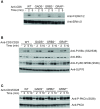Mapping the SLP76 interactome in T cells lacking each of the GRB2-family adaptors reveals molecular plasticity of the TCR signaling pathway
- PMID: 37006259
- PMCID: PMC10057548
- DOI: 10.3389/fimmu.2023.1139123
Mapping the SLP76 interactome in T cells lacking each of the GRB2-family adaptors reveals molecular plasticity of the TCR signaling pathway
Abstract
The propagation and diversification of signals downstream of the T cell receptor (TCR) involve several adaptor proteins that control the assembly of multimolecular signaling complexes (signalosomes). The global characterization of changes in protein-protein interactions (PPI) following genetic perturbations is critical to understand the resulting phenotypes. Here, by combining genome editing techniques in T cells and interactomics studies based on affinity purification coupled to mass spectrometry (AP-MS) analysis, we determined and quantified the molecular reorganization of the SLP76 interactome resulting from the ablation of each of the three GRB2-family adaptors. Our data showed that the absence of GADS or GRB2 induces a major remodeling of the PPI network associated with SLP76 following TCR engagement. Unexpectedly, this PPI network rewiring minimally affects proximal molecular events of the TCR signaling pathway. Nevertheless, during prolonged TCR stimulation, GRB2- and GADS-deficient cells displayed a reduced level of activation and cytokine secretion capacity. Using the canonical SLP76 signalosome, this analysis highlights the plasticity of PPI networks and their reorganization following specific genetic perturbations.
Keywords: GRB2-family adaptors; SLP76; T cell signaling; TCR; mass spectrometry.
Copyright © 2023 Ruminski, Celis-Gutierrez, Jarmuzynski, Maturin, Audebert, Malissen, Camoin, Voisinne, Malissen and Roncagalli.
Conflict of interest statement
The authors declare that the research was conducted in the absence of any commercial or financial relationships that could be construed as a potential conflict of interest.
Figures






Similar articles
-
GADS is required for TCR-mediated calcium influx and cytokine release, but not cellular adhesion, in human T cells.Cell Signal. 2015 Apr;27(4):841-50. doi: 10.1016/j.cellsig.2015.01.012. Epub 2015 Jan 28. Cell Signal. 2015. PMID: 25636200 Free PMC article.
-
Bridging the Gap: Modulatory Roles of the Grb2-Family Adaptor, Gads, in Cellular and Allergic Immune Responses.Front Immunol. 2019 Jul 25;10:1704. doi: 10.3389/fimmu.2019.01704. eCollection 2019. Front Immunol. 2019. PMID: 31402911 Free PMC article. Review.
-
Quantitative interactomics in primary T cells unveils TCR signal diversification extent and dynamics.Nat Immunol. 2019 Nov;20(11):1530-1541. doi: 10.1038/s41590-019-0489-8. Epub 2019 Oct 7. Nat Immunol. 2019. PMID: 31591574 Free PMC article.
-
PI3Kδ Forms Distinct Multiprotein Complexes at the TCR Signalosome in Naïve and Differentiated CD4+ T Cells.Front Immunol. 2021 Mar 8;12:631271. doi: 10.3389/fimmu.2021.631271. eCollection 2021. Front Immunol. 2021. PMID: 33763075 Free PMC article.
-
LAT, the linker for activation of T cells: a bridge between T cell-specific and general signaling pathways.Sci STKE. 2000 Dec 19;2000(63):re1. doi: 10.1126/stke.2000.63.re1. Sci STKE. 2000. PMID: 11752630 Review.
Cited by
-
Survival and Developmental Progression of Unselected Thymocytes in the Absence of the T-Cell Adaptor Gads.Eur J Immunol. 2025 Feb;55(2):e202451000. doi: 10.1002/eji.202451000. Eur J Immunol. 2025. PMID: 39989300 Free PMC article.
-
Editorial: Community series in adaptor molecules in T cell signaling, volume II.Front Immunol. 2023 Jul 26;14:1243039. doi: 10.3389/fimmu.2023.1243039. eCollection 2023. Front Immunol. 2023. PMID: 37564638 Free PMC article. No abstract available.
References
-
- Buday L, Egan SE, Rodriguez Viciana P, Cantrell DA, Downward J. A complex of Grb2 adaptor protein, sos exchange factor, and a 36-kDa membrane-bound tyrosine phosphoprotein is implicated in ras activation in T cells. J Biol Chem (1994) 269(12):9019–23. doi: 10.1016/S0021-9258(17)37070-9 - DOI - PubMed
Publication types
MeSH terms
Substances
LinkOut - more resources
Full Text Sources
Research Materials
Miscellaneous

